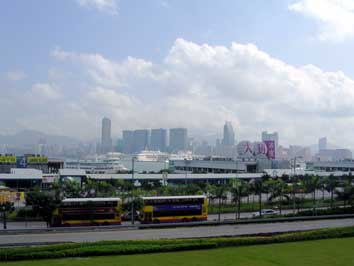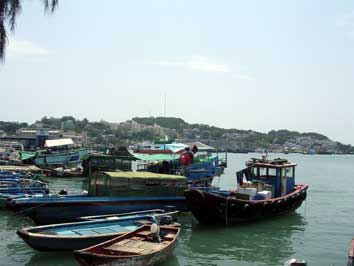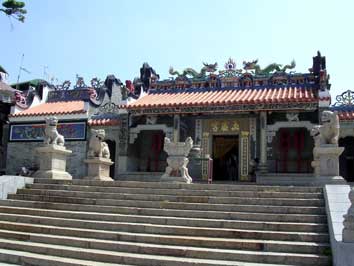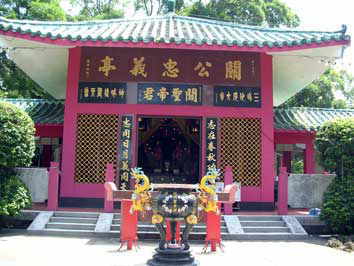| 長洲島(Cheung Chau)ウォーキングガイド (MAP) (提供:香港政府観光局 Hong Kong Walks in 2003) |
|||
|
|||
 |
|||
|
|||
| To get to Cheung Chau, take the ferry from Outlying Islands Ferry Pier
No.5 in Central. Information about ferry schedules can be obtained from
Hong Kong Tourism Board Visitor Information and Services Centers. When
you arrive at Cheung Chau, walk north along Pak She Praya Road. 長洲(Cheung Chau)へ行くには中環(Central)の5番フェリー乗り場から離島行きのフェリーに乗ります。運航スケジュールについての情報は香港政府観光局かサービスセンターで入手できます。島に着いたら海傍街(Praya Street)を北へ向かって歩いてください。 |
|||
 |
|||
| Ferry passengers arriving on Cheung Chau are often fascinated by the sight
of fishing families maintaining traditional life styles aboard authentic
wooden junks equipped with radar and computer systems. There is no vehicular
traffic on this tiny, dumbbell-shaped island, which is ideal for walking
and soaking up the traditional atmosphere. Hugging the shore on reclaimed
land, Praya Street uses the Portuguese name (imported via Macau) for a
harborside avenue - the "Praya". Along the waterfront, seafood
is dried in the sun and fishmongers sell fresh shellfish and seafood in
shops and restaurants. In the evenings, the road becomes a colorful Mediterranean-style
promenade for islanders; at weekends it is lively with day-trippers from
all over Hong Kong. フェリーで長洲(Cheung Chau)へ到着する乗客はしばしばレーダーとコンピューターシステムを搭載した本物のジャンク船に乗って生活する伝統的な漁師の家族たちの姿に魅了されます。 この小さく砂時計のような島には自動車が通る道がなく、昔ながらの雰囲気を味わって散策するには理想的な場所です。 埋め立てられた海岸沿いを歩くと湾内の通りの名前にポルトガル語でビーチを意味するプライア(Praya)が使われています。 海岸沿いには天日で乾燥したシーフードがあり、魚商たちがレストランや店先で新鮮なシーフードを売っています。 毎日、夕方になると通りは島民たちにとってカラフルな地中海様式のプロムナードに変わり、週末は香港中から来る日帰り客で活気に溢れます。 |
|||
|
|||
| Pak Tai Temple lies right behind the big playground. 北帝廟(Pak Tai Temple)は、大きな運動場のすぐ奥にあります。 |
|||
 |
|||
| Built more than two centuries ago, the temple is dedicated to the Taoist
god of the sea, the "Supreme Emperor of the Dark Heaven". Pak
Tai's power is symbolized by the serpent and tortoise under his feet. Before
his altar are statues of two generals, "Thousand Miles Eye" and
"Favorable Wind Ear", who are said to be able to see and hear
from any distance. Side halls display images of the Green Dragon and White
Tiger, and the complex includes many features of traditional Chinese temple
architecture, such as ceramic figurines on roof ridges and stone lions
on the forecourt. In the 18th Century, Cheung Chau was devastated by a
plague and infiltrated by pirates - until local fishermen brought an image
of the god Pak Tai to the island. Paraded through the village lanes, the
deity drove away evil spirits. Every year on the 8th day of the fourth
month of the Lunar calendar, the islanders organize a week-long thanksgiving,
the Cheung Chau Bun Festival (usually in April or May). The festival features
huge towers covered with buns erected in front of the Pak Tai Temple and
a street procession in which costumed children appear to float above the
crowds, supported by hidden rods and wires. Pak Tai Temple is open daily
9am to 5pm. 2世紀以上前に建てられたこの廟は道教の海神、"Supreme Emperor of the Dark Heaven"が奉納されています。 北帝(Pak Tai)の力は彼の足の下にあるへびとカメによって象徴されています。 彼の祭壇の前には2つの将軍、"Thousand Miles Eye"と "Favorable Wind Ear"の像があり、彼らはどんなに遠くに離れているものでも見聞きできる、と言われています。 脇の廊下は、緑龍と白虎の絵が展示され、建物自体にも屋根上の陶器の置物や前庭のライオンの石像ような伝統的な中国の寺院建築の多くの特徴が見られます。 18世紀、長洲(Cheung Chau)は地元の漁師が島に北帝(Pak Tai)神の像を持ってくるまでは、疫病で荒廃し、海賊が荒らし回っていました。 神は村の小道を行進し、悪霊を追い出しました。 毎年、太陰暦(the Lunar calendar)の第4月の8日(通常の暦では4月か5月)、島民は1週間にわたって饅頭節(Bun Festival)という感謝祭を行います。 この祭りの出し物のメインは北帝廟(Pak Tai Temple)の前に建てられた饅頭で覆われた大きな塔と、いろいろなコスチュームに身を固めた子どもたちの乗った山車が通りを練り歩くものです。 北帝廟(Pak Tai Temple)は毎日9時から5時までオープンします。 |
|||
|
|||
| From Pak Tai Temple, walk along Rak She Street and San Hing Street. 北帝廟(Pak Tai Temple)から北社街(Pak She Street)と新興街(San Hing Street)を歩きます。 |
|||
| Pak She Street and San Hing Street form Cheung Chau's old main street.
The scene is typical of island communities: three-storey balconied shop-houses
flank a narrow pedestrian lane which follows the contour of the original
coastline before it was reclaimed. Stroll along these streets past rebuilt
blocks and modern shops and you will see people still practicing traditional
trades - baking lotus-seed cakes, dispensing herbal medicine or manufacturing
and selling Cheung Chau's famed, pungent, purplish-brown shrimp paste.
In clan and community associations, memorial plaques and photographs line
the walls. 北社街(Pak She Street)と新興街(San Hing Street)は長洲(Cheung Chau)の昔の主要街道です。 通りの光景は典型的な島民のコミュニティで、バルコニーのある店舗住宅が埋め立てられる前の元の海岸線へと続くありきたりの小道の脇に立っています。 これらの通りをぶらぶら歩き、改築された区画やモダンな店を過ぎると、昔ながらの商売をいまだにやっている人たちを見れるでしょう。 それは自家製のケーキを焼いていたり、漢方薬(herbal medicine)の調剤をしていたり、有名な紫褐色のエビペーストを作ったり売ったりしています。 彼らの仲間うちでは記念の額と写真を壁に並べています。 |
|||
|
|||
| From San Hing Street turn into Tung Wan Road and continue until you come
to Cheung Chau Beach Road. 新興街(San Hing Street)から東灣路(Tung Wan Road)へ曲がり、長洲東堤路(Cheung Chau Beach Road)へたどり着くまで歩き続けます。 |
|||
 |
|||
| Cheung Chau's "town" crowds the narrow sandbar linking the two
hilly ends of the island. On the eastern side, only a few minutes' walk
across the island from the ferry pier, is Tung Wan, a popular public beach.
In the waters off to the right beyond the Warwick Hotel Cheung Chau, Hong Kong's first Olympic Games gold medalist (in 1996), Lee Lai-shan,
practiced as a schoolgirl. The local Windsurfing Center teaches the sport. 長洲(Cheung Chau)の町は山の多い島の北端と南端をつなげる狭い砂州にひしめきあっています。 東方にはフェリー乗り場から島を横切る形で歩いて数分のところに人気のビーチ、東灣(Tung Wan)があります。 ビーチの右側には香港で最初のオリンピック金メダリスト(1996年)の季麗珊(リー・ライシャン/Lee Lai-shan)が女生徒時代に練習していた長洲華威酒店(Warwick Hotel Cheung Chau)があります。 地元のウィンドサーフィンセンターではその競技を教えています。 |
|||
|
|||
| Walk uphill along Cheung Chau Sports Road and turn right into Kwun Yam
Wan Road, Kwan Kung Pavilion lies ahead. 長洲體育路(Cheung Chau Sports Road)を上り、右折して観音灣路(Kwun Yam Wan Road)を進むと前方に關公忠義亭(Kwan Kung Pavilion)があります。 |
|||
 |
 |
||
| Inland from Tung Wan, the colorful Kwan Kung Pavilion is a gilded, lacquered
temple dedicated to Kwan Tai, the Taoist God of War and Righteousness.
Leave the temple, walk down Peak Road to Police Station Path and into Tung
Wan Road. From there you can catch the ferry back to Central. 東灣(Tung Wan)から内陸にある、戦争と正義の神、關帝(Kwan Tai)を奉納した色彩やかな關公忠義亭(Kwan Kung Pavilion)は金箔を貼った漆塗りの寺です。 寺院見学を終えたら山頂道(Peak Road)を下り、警署徑(Police Station Path)を経て東灣路(Tung Wan Road)へ行きます。 そこから中環(Central)へ帰るフェリーに乗ることができます。 |
|||
| 関連サイト | |||
| [総合リンクのページへ戻る] [2004年香港・マカオ旅行記へ戻る] |
|||